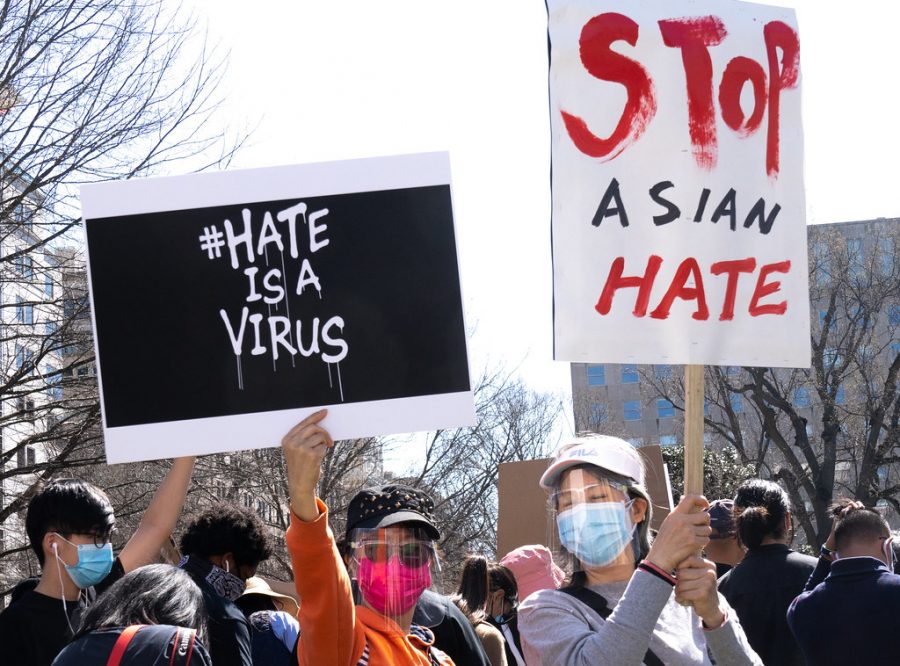The Stop Asian Hate Movement
People protest across the globe to raise awareness.
June 2, 2021
In the past year, there has been a significant increase in racism and discrimination against the Asian American Pacific Islander (AAPI) community within the United States. This is evident in the rise of hateful rhetoric and violence targeted towards this group.
Many attribute this rapid increase to the actions and comments of former President Donald Trump that followed the beginning of the COVID-19 pandemic. Flare magazine online describes one instance of this harmful speech.
“On September 29, during the first presidential debate ahead of the 2020 U.S. Election,
President Donald Trump made inflammatory remarks regarding the COVID-19 virus…’It’s China’s fault,’ he said. ‘It should have never happened.’ He also referred to COVID-19 as the ‘China plague,’” the article stated.
Time stated that by using this rhetoric, “Trump followed in a long American history of using diseases to justify anti-Asian xenophobia, one that dates back to the 19th and 20th centuries and has helped to shape perception of Asian Americans as ‘perpetual foreigners.’’
Flare also cited that, according to a report completed in October 2020 by the Anti-Defamation League, “there was an 85 percent increase in anti-Asian rhetoric and conspiracy theories on Twitter shortly after Trump used those terms during the first presidential debate in the fall.”
Hateful rhetoric targeting the AAPI community from within the highest levels of government has inspired an increase of similar rhetoric and hate from within portions of the general population. This has continued to increase in the past six months, increasingly frequently culminating in specific cases of violence against AAPI individuals.
A national report released by stopaapihate.org on March 16 presented statistics about 3,795 incidents the Stop AAPI Hate reporting center received between March 19, 2020, and February 28, 2021, nearly a year later. The organization reported that verbal harassment (68.1%) and shunning (20.5%) were the two leading types of discrimination in the period, followed by physical assault (11.1%), Civil Rights violations (8.5%), and online harassment (6.8%).
The organization reported that “businesses are the primary sites of discrimination (35.4%), followed by public streets (25.3%), and public parks (9.8%). Online incidents account for 10.8% of the total incidents.”
Stop AAPI Hate received reports of incidents from all 50 states and the District of Columbia (Washington, DC). This indicates the widespread nature of anti-AAPI incidents. Anti-Asian violence has taken place nationwide, particularly in major cities.
In the first few months of 2021, the focal point of attacks has been in heavily populated areas of California, specifically, the Bay Area around San Francisco and Oakland.
On March 16, eight people were killed in a targeted attack against three Asian-owned spa parlors in Atlanta, Georgia. Six of the victims were Asian women. This tragedy gained media coverage due to the significance of the shooting and the following police investigation in exemplifying the increasing discrimination and violence against the AAPI community, as well as the government’s ignorance and avoidance of this issue.
Many were angered by the manner in which the ensuing police case was conducted, believing that, according to opensocietyfoundation.org, “many in the media and law enforcement were quick to flatten the Atlanta shooter’s story to one motive, they ignored the most toxic intersecting factors plaguing society today and contributing to rampant violence: white supremacy, misogyny, permissive gun culture, and classism.”
These events sparked public outrage and outcry. Social media users began to call for an end to the discrimination against the AAPI community, using the hashtag “Stop Asian Hate,” which quickly went viral.
The phrase has quickly evolved into something much more than a hashtag. It has become the slogan that represents a growing movement. Similarly to the progression of the Black Lives Matter campaign that has experienced a resurgence throughout the past year, the Stop Asian Hate movement has quickly developed into a network of activism.
Posts are being shared, organizations are being developed, funds are being raised, and protests are being held throughout the country. Millions of people continue to contribute to the effort to call attention to discrimination and injustice against AAPI the community, and to demand change.



